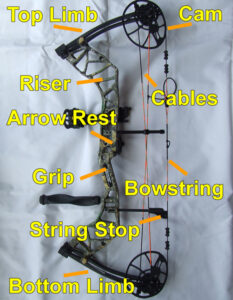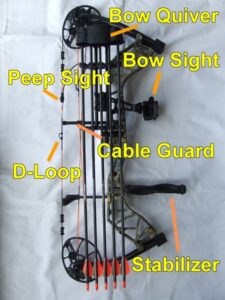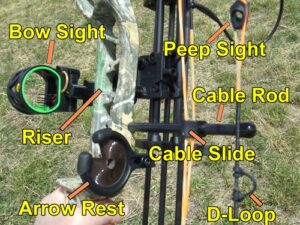Parts Of A Compound Bow (With Diagrams)

The compound bow is a great bow with a lot of high tech features far from traditional archery bow design. However, with all the extra bow parts, the terminology can be confusing. So here are the parts of the compound bow with diagrams and names.
We will also cover the bow parts with added accessories like bow sights, stabilizer and bow quiver.

What is a bow riser?
The bow riser is the main section of the bow with the handle on it and the limbs connect to it.
Compound bow risers have mounting holes for accessories to be attached like the: bow sight, arrow rest, stabilizer and cable guard.
Above the grip is the shelf, is where the arrow rest goes.
The compound bow riser is shaped / cut off center, between the bow grip and sight window. A center shot riser helps so the arrow can be nocked and released without contacting the bow riser. Bow clearance, accuracy and potentially making the bow and arrow set up easier to tune are some benefits of a center shot bow.
(As opposed to a bow like a longbow design, were the arrow rest shelf and riser is not centershot. The arrow sticks out partially sideways from the riser. This also means the precisely spined arrow needs to be used. Otherwise the arrow won’t tune well or fly straight.)
A compound bow riser is normally made with a combination of metals. Some top end bows can have a graphite / carbon construction.
Older compound bows had a solid riser, some were even made out of wood. Today the risers have a skeleton high tech cut out to save weight, but still give the bow a solid design, yet lighter weight and reduce hand shock.
Target compound bows will have a longer riser for stability.
A bowhunting compound bow will have a shorter riser so it can be maneuvered easier in a tree stand or hunting blind.

Bow grip.
The bow grip is located in the middle of the bow riser. Some risers have a replaceable grip, which might be a plastic or plastic / wood material.
Some target compound bows and bowhunting models have low, medium and high grip options that can be changed to suit the archers shooting style and preference.
What is a Berger button hole?
The Berger hole or is on the bow riser and it is where the arrow rest will go or to be mounted near. It can also be used for a plunger button which is part of an arrow rest.
The arrow is lined up level with the Berger button hole.
Normally the Berger button hole is located above the pivot point of the bow handle. (But not always.)
Bow limbs.
The upper and lower bow limbs attach to the bow’s riser and cams.
The bow limbs flex when the bow is drawn back. Today’s modern compound bows have very short limbs and are strung under pressure with a near parallel limb design that works with large cams for good arrow speed.
Some limbs are one piece and are made out of all types of carbon, fiberglass materials.
The older style compound limbs were laminated wood and fiberglass construction, some of them had a long, recurve type design. (They basically looked like a recurve bow with wheels on them.)
The limb pockets.
The limb pocket or / and limb rockers, help align the limbs align and attach to the bow’s riser. Limb pockets can be made of hard plastic or a combination of metals.
Limb bolts.
A limb bolt is placed through the limbs or limb pocket to adjust the bows poundage. The bolts can be wound up or down to decrease, or increase the draw weight.
The limb bolts fully tightened down will be the maximum draw weight the compound bow is capable of.
As an example a compound bow of 70 pounds, with the limb bolt fully wound down, will be 70 pounds. lf you unwind the limb bolts evenly, the bows poundage will decrease. If you wind two turns of the limb bolts out, that might adjust the bow’s poundage to be around 65 pounds.
Bows will differ from brand and model, but one complete turn of limb bolt might adjust the poundage from 2 to 4 pounds.
Both the top limbs and bottom limbs should be evenly adjusted when the bow weight is adjusted.
A clockwise turn of the limb bolt will increase the bow peak weight. Counter clockwise turns of the limb bolt will decrease the bow poundage.
Never wind the limb bolt more than one or two complete turns, without then adjusting the other limb bolt evenly. As an example don’t just wind the top limb bolt 4 turns, then the bottom 4 turns. Do the top limb bolt 2 turns, then the bottom limb bolt 2 turns, etc.
The bow manufacture manual should state how far you can back-out or decrease the bow’s peak weight from. E.g. “Maxim limit 4 turns out from peak bow weight.”
Caution- If you unwind the limb bolts too far out, the limbs can go flying off the riser, as the compound bow is strung under pressure.
Bowstring and cables.
The bowstring is attached to the cams or wheels, which in turn are connected to the cables. The cables with the cams help reduce the holding weight.
The bowstring is covered with serving in the center and ends. This helps protect the bowstring strands when in the cam grooves.
Center serving also helps protect the individual bowstring strands from a finger release, or release aid device attached to it. It also protects the strands from attaching noc sets and d-loops to it.
The center serving also helps achieve the correct arrow nock fit on the bowstring. Click on, How tight should an arrow nock be? for more information on the correct fit.
The cables are also covered with a portion of serving to protect them from wear in the cam tracks.
For learning more about bowstrings and types, visit Bowstrings and How Often Should You Wax Your Bowstring?
Cams, wheels and idler wheels.
The cams and wheels are positioned off center and rotate when the bowstring is drawn back to full draw. This turns the cams over and reduces the bows poundage or holding weight when at full draw.
The let off design of the cams is the same design as pulleys and cables from a block and tackle.
As an example if the bow is 60 pounds draw weight, when the compound bow is pulled back, the archer will reach this peak weight (hump) then come to the valley of the draw cycle. This valley of the draw cycle is the let off amount. The archer might at full draw be holding 50% of the original draw weight (60 lbs.) which would be 30 pounds holding weight in the valley.
The let off helps the archer when aiming to hold the bow longer on target if they choose. Also they are not struggling to hold a 60 pound bow when at full draw, like a longbow or recurve bow.
Target bows may have wheels or less aggressive cam design for a smoother drawing of the bowstring.
Some bows have one cam on the bottom and an idler wheel at the top. One advantage of the solo cam design is: compared to a dual cam bow is the cam doesn’t go out of tune. With a two cam bow, both cams should turn over at the same time for a smoother draw and even limb tiller. If these cams are out of synchronization this can cause bow tuning issues. A solo cam design bow doesn’t have this issue.
Twin cam bows are have generally more arrow speed then single cam bows.
Very aggressive speed bows have large cams, but can be harder to pull back as the draw cycle is not as smooth.
What is a peep sight?
The peep sight helps align the bowstring with the front bow sight and with the target. It is similar to a rear rifle iron sight.
The peep sight is inserted in the bowstring. Some archers line up the inner peep sight ring with the outer bow sight ring or housing for accuracy.
A larger hole peep sight allows more light in and is popular with bowhunters for hunting in low light conditions, such as at dusk and dawn.
Target archers may prefer a smaller peep sight for more accuracy.
One problem with peep sights is the bowstring may not always rotate around properly when at full draw, making the peep sight hard to see through. Good quality bowstrings, pre-stretched and the bow being “shot in” helps this issue.
Cable guard.
The cable guard helps move the bows cables out of the way of the arrow being released.
Some cable guards use rollers, others use a cable slide and rod. Some cable slides have a Teflon coating or similar that helps slide it on the cable guard rod smoothly.
String suppressor.
A string stop or string suppressor helps stop the bowstring going forward too much and oscillating when the bowstring is released. This helps reduce vibration and noise.
What are nock sets?
Nock sets help position the nocked arrow on the bowstring consistently time after time. If you don’t use a nock set, the arrow can slide up or down the string upon release.
You can use one either above or below the arrow, or two, either side of the nocked arrow.
Nock sets can be a metal design that is clamped on the bowstring. You can also tie on a nock with material like dental floss or cotton. Tied on nock sets are popular with target archers and for using with a d-loop.
There are many variations on how to fit them on your bowstring, with advantages and disadvantages for each set up and design.
For more information visit – Knocking points and d-loops set ups.
D-loops.
D-loops are used on a compound bowstring for three main reasons.
The d-loop can help reduce wear on the bowstring, as the release aid device is connected on the d-loop and not connected directly on the bowstring. The jaws of the caliper release aid device can sometimes cause excessive wear on the bowstring.
A d-loop also helps reduce torque and hence, more potential accuracy as the release is not directly attached to the bowstring.
Firmer d-loop material might be favored by bowhunters as the d-loop is easier to connect too quickly if the bowhunter sees game.
A softer d-loop material may be preferred by target compound archers as the softer cordage may be less prone to torque.
Another good reason for tying a d-loop on is the bowstring is released directly behind the arrow with the release aid device. This can help with bow tuning and accuracy as you don’t have the same issues as a split finger release, (Mediterranean release.) or a three finger under release. (Apache style release.)
Click on, How to tie a d-loop correctly on a bowstring.
Bow sights.
Compound bows can be shot barebow (Without sights.) or with bow sights.
However because most new model compounds are very short, a release aid device is used. (A short length compound is very hard to shoot with a finger release.) As a release aid is used with the compound bow, normally sights are used as well.
There are a wide range of bow sights around. The best compound bow sights are normally very robust, so they don’t lose their sight adjustments if they get bumped or knocked about.
Most bowhunting sights have multiple pins for different distances.
Some multiple pin bowhunting sights, might have from 3 pins to five pins on the sight. As an example the top pin is set for 20 yards, the next pin down is set for 30 yards. The next pin down is for 40 yards.
High quality brands have bright optic fiber pins in the bow sights.
Some sights also have a night light for low light conditions to see the target.
A bubble level is on the bottom of some sights to help level the bow vertically and help ensure the bow is not canted, which can affect the accuracy of the sights. (Olympic archery style uses a recurve bow and doesn’t allow a bubble float on the bow sight.)
Some bowhunting sights have a single pin, where you can adjust it up and down for the different distances to the target.
Target bow sights have one pin that is adjustable for windage and elevation. They have a long extension bar that helps put the sight pin further from the eye.
Click on How To Aim A Bow And Arrow for more information on aiming techniques and methods of shooting.
What is a bow stabilizer?
The stabilizer is a long rod that screws into the stabilizer mount on the bows riser. It has a weight on the very end that helps reduce bow torque when the archer is at full draw and helps steady the bow on target.
The end weights are adjustable so the archer can change the weight to suit their shooting style and preference.
A stabilizer also helps to tilt the bow forward for a consistent direction during the release and after the shot execution.
Target bows will use a longer stabilizer.
A bowhunting stabilizer will be shorter than a target stabilizer. Most bowhunting stabilizers also help have a rubberized coating on the rod or end weight to also help reduce vibration and bow noise.
Some very short bowhunting stabilizers are not true stabilizers in a sense, but more of a vibration dampener for the bow as they don’t help and assist with aiming. These so called stabilizers don’t have any weight/s on the end of the rod and are too short for reducing torque of the bow.
Stabilizer rods can be made from alloy, fiberglass, carbon or a mixture of materials.
Bow quivers.
A quiver holds the arrows for the archer when bowhunting. A bow quiver has many advantages for hunting and some drawbacks.
One advantage is the arrows are always with the bow. Also the bowhunter can get easy access to the arrows in a lot of positions with waiving the arrow about scaring any game from excessive movement. (As opposed to a back quiver.)
The bow quiver hood keeps the broadheads safe and stops them from rattling and getting dull and causing extra noise.
One negative is the extra weight of the bow quiver, which can help the bow be steadier for aiming, but can be too heavy for some. Also some bow quivers can tilt the bow off to the side when aiming.
(A bow quiver like the TightSpot quiver can be adjusted close to the bow and help this problem. The TightSpot quiver is available from Amazon. You can check the latest price on by clicking here on Amazon TightSpot Bow Quiver.)
Target archers don’t use a bow quiver as the weight can tip the bow to the side. Also the balance and weight will change after each arrow is taken out of the bow quiver to be shot. A target archer will use a hip quiver.
What is brace height on a bow?
The brace height is the length from the pivot point to the bowstring when bow is strung. (Not at full draw.) A bow square, “T” square or ruler can be used to measure it.
Traditionally the brace height was called “Fistmele” and was used to measure a longbows brace height with a fist and thumb sticking up. The fist was placed on the bow grip and the thumb was extended. The end of the thumb tip was approximately were the bowstring would be when the longbow was strung.
Resources and extra information on the compound bow.
The Bear Archery Legit was used for some of the photos above, click on Bear Archery Legit compound review for more information about it.
Visit – How to measure a bows draw length.
For parts and names of an arrow click on Parts of an arrow
Click on How To Figure Out Your Draw Length and Correct Draw Length for more information.

